Apocalypse Visions From the Book of Revelation in Western Art
The eerie historical visions that predict the apocalypse
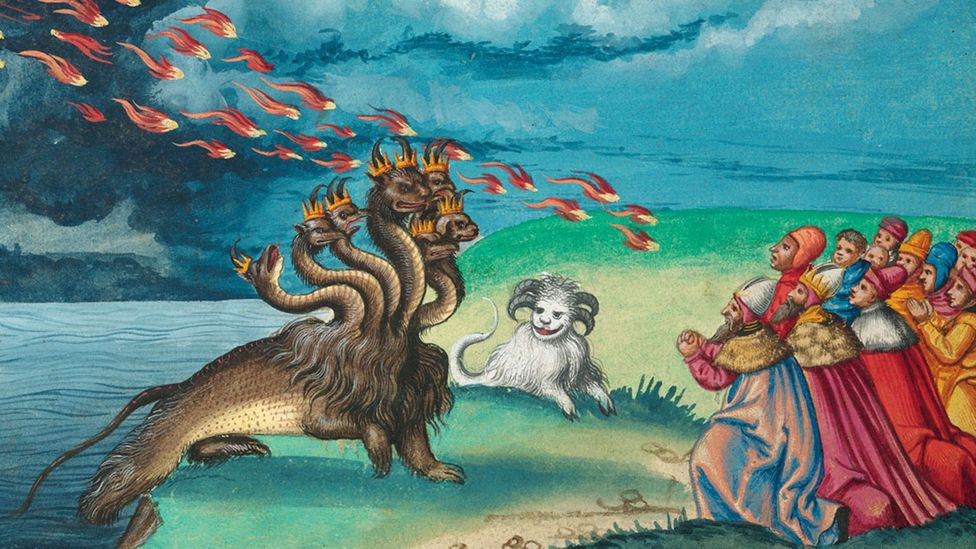
The Augsburg Volume of Miraculous Signs reveals a 16th Century society gripped by anxieties that we can relate to in the 21st Century, writes Rebecca Laurence.
G
Giant locusts swarm around a jagged aquamarine mountain. Cracking whales and strange beasts flounder amid stormy seas. Inky skies rain hailstones and blood. These bizarre and terrifying visions are found in the Augsburg Volume of Miraculous Signs, also called the Book of Miracles. Information technology is a beautifully illustrated manuscript created in the High german city in the mid-16th Century but but recently discovered and now collected in a new edition, by Till-Holger Borchert and Joshua P Waterman.
Golden balls
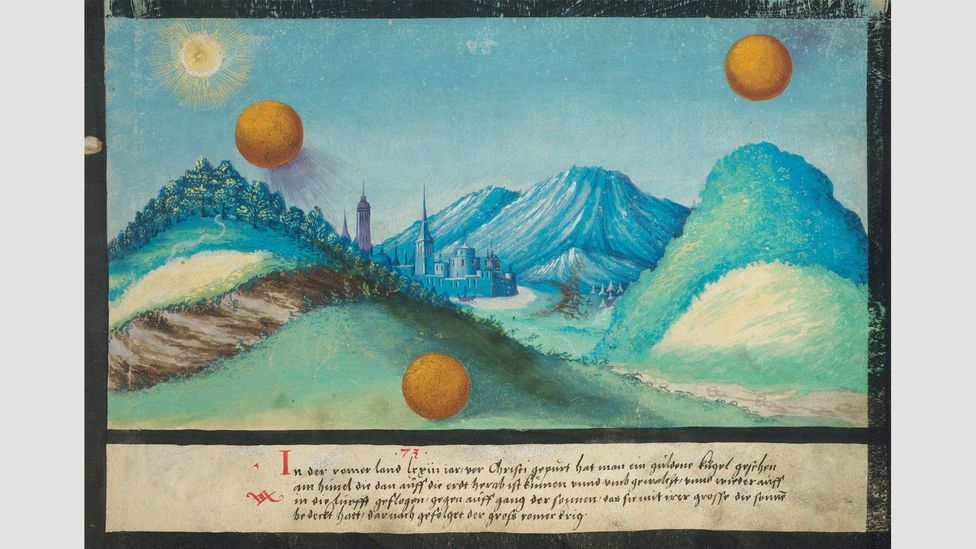
(Credit: The Book of Miracles / Taschen)
"I remember that when I beginning saw the images in the flesh," Till-Holger Borchert tells BBC Culture, "I was awestruck by the very touching combination of simplicity and dazzler in systematically depicting catastrophes of all times."
"These stunningly vivid pictures must certainly accept imparted to those readers get-go seeing them a sense of awe at the progression of disasters and wonders from the beginning of history to the end of time, every bit then understood," writes Waterman. The starting time half of the volume concerns the Old Testament, while the second spans from antiquity through to the mid 1500s, when the book was produced. It ends with stories from the Book of Revelation.
Feel the burn
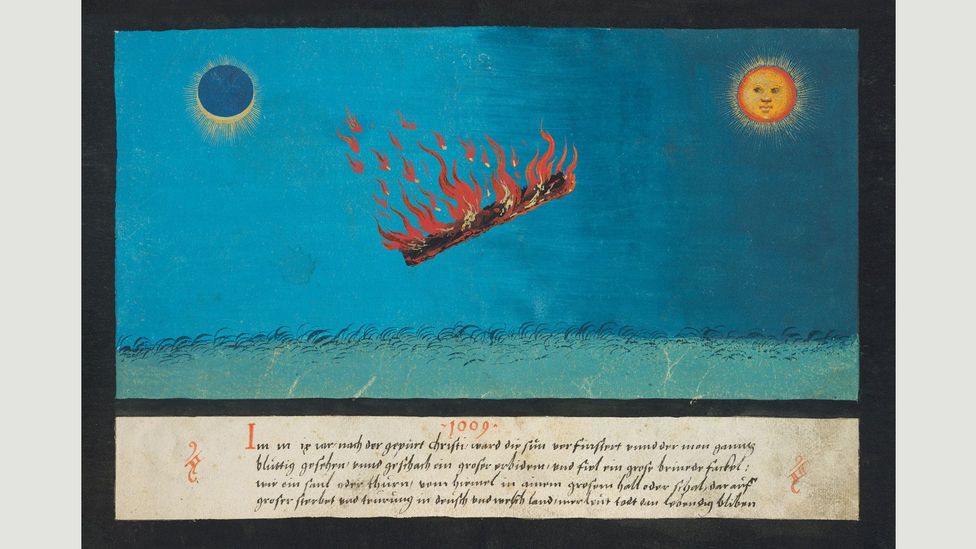
(Credit: The Volume of Miracles / Taschen)
Each image, such equally 1009 - Called-for torch, is accompanied by a explanation that leaves no doubt equally to its grim message: "In the year AD 1009, the sun went dark and the moon was seen all bloodcerise and a keen earthquake struck and at that place fell from the sky with a loud and crashing dissonance a huge called-for torch like a column or a tower. This was followed past the death of many people and famine throughout Germany and Italy. More than people died than remained live."
By drawing from ancient, biblical and contemporary traditions of prophecy in roughly chronological order, The Book of Miracles follows an established structure like to other gimmicky books of wonders. Information technology'due south a tradition that highlights the period's ordering of history through the prism of apocalyptic signs and visions. "When studying this one-of-a-kind series of illustrations," Waterman says, "it's important to keep in mind the structuring principle of Christian world history."
"The 16th Century's obsession with miraculous signs has its primary origin in faith, specifically in the upheavals of the Protestant Reformation," he notes. Borchert agrees. "The late medieval councils had left Christendom in an insecure state, and the Reformation tried to fill the void," he explains. "There was a general sense and urgency apropos the afterlife and the all-time fashion to secure 1'south fate." A widespread and imminent sense of disaster "created a sphere of feet in which those miraculous signs played an important role."
The 'Papal Donkey'
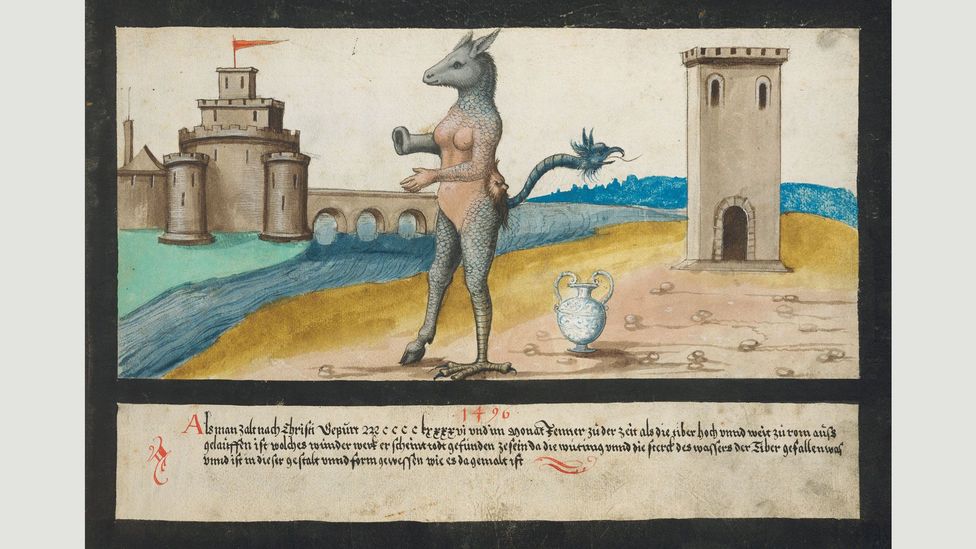
(Credit: The Book of Miracles / Taschen)
Many of the book'south images, such as the 1496 Tiber monster, have their origins in contemporary folklore: a monster was said to have been plant in Rome on the banks of the Tiber after a flood of 1496. But, Waterman says the animal is also "the prime example" of phenomena that he says were "put to propagandistic or polemical utilise." In 1523, Martin Luther and his colleague Philipp Melanchthon published a pamphlet in which they depicted the donkey-similar beast as the 'Papal Ass', to correspond the abuse of the Roman Cosmic church.
"Scholarship has identified a potent apocalyptic slant in the thinking of Martin Luther and in early on Lutheranism in general" Waterman explains, "fueled in function past a conventionalities that the antichrist was present on earth in the person of the Pope."
But although apocalyptic Lutheranism helps to place The Augsburg Book of Miracles firmly in its time, Luther's polemical version of the Tiber monster story, Waterman explains, is entirely absent-minded from the certificate. "Augsburg was a free regal city, thus directly subordinate to the Holy Roman Emperor… For that reason, anti-Cosmic polemics were in no way advantageous to Augsburg's elites."
The Lisbon whale
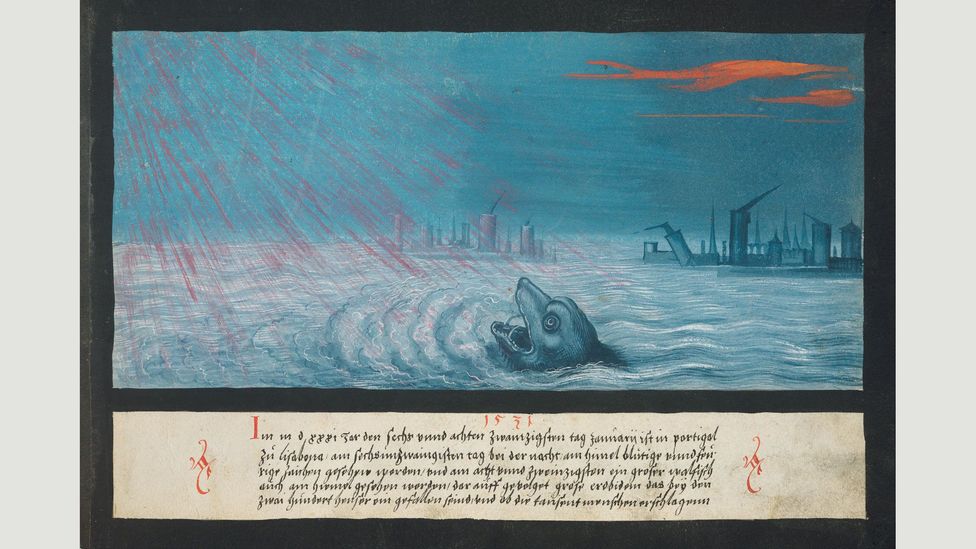
(Credit: The Volume of Miracles / Taschen)
"In the year 1531, on the xx6th and the twenty8th of Jan, encarmine and fiery signs were seen at night in the sky in Lisbon in Portugal on the twenty6th twenty-four hours and then on the twentyeighth a keen whale was seen in the sky. This was followed past great earthquakes, so that about two hundred houses collapsed and more than a thousand people were killed."
The 'Lisbon whale' demonstrates how stories were disseminated beyond Europe through media including messages and pamphlets, in what Waterman describes as "the primeval forms of mod news networks," that ran along existing trade routes. He cites the 'Fugger newsletters' (Fuggerzeitungen), named after the Augbsurg-based Fugger family, as the prime example of "handwritten newspapers with reports of noteworthy events in Europe and abroad, including disasters and miraculous phenomena." The sighting of the Lisbon whale, which was followed by several disasters, is one such story where the news was first transmitted by letter and so into print and illustrated media, including the Augsburg Book of Miracles.
Celestial creatures
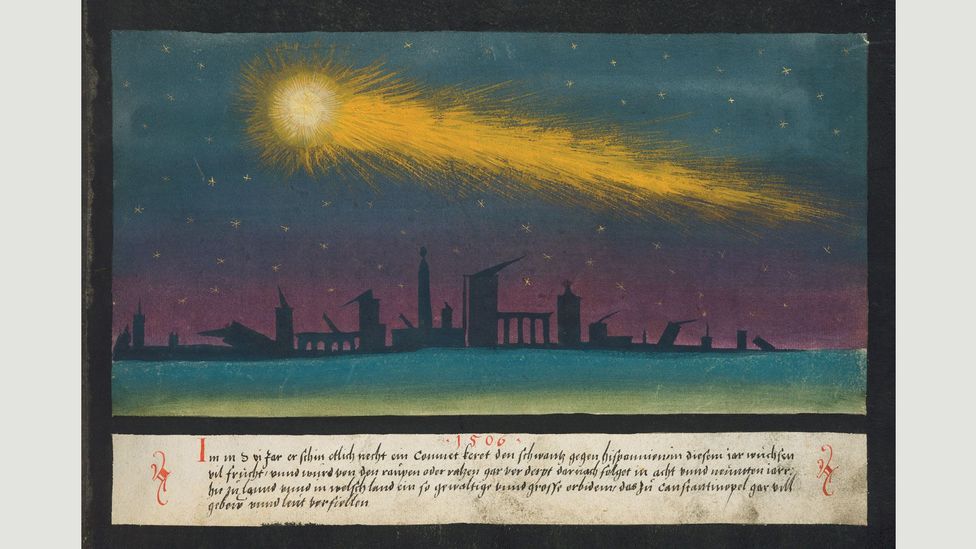
(Credit: The Book of Miracles / Taschen)
"In the year 1506, a comet appeared for several nights and turned its tail towards Espana. In this year, a lot of fruit grew and was completely destroyed past caterpillars or rats. This was followed eight and nine years later on, in this land and in Italian republic, past an earthquake, so cracking and fierce that in Constantinople a slap-up many buildings were knocked downward and people perished."
A contemporary preoccupation with astrological prophecy helps to explain why documents such every bit the Book of Miracles abound with suns and moons, and peculiarly comets, which were in artifact considered harbingers of doom. "Authors such equally Johannes Virdung von Haßfurt (1463–1538/39) published yearly predictions of world affairs based on sightings of comets and conjunctions of celestial bodies," writes Waterman, and he notes that along with a "treatise" on the field of study published around 1587 in Flanders, the Augsburg Book of Miracles represents the largest early collection of comet pictures.
The comet images in the Volume of Miracles often appear accompanied past natural disasters such as earthquakes, floods and plagues which Waterman explains were all "understood as role of a continuum of divine omens that foretold the coming apocalypse and called upon humanity to do penance for their sins."
All hail!
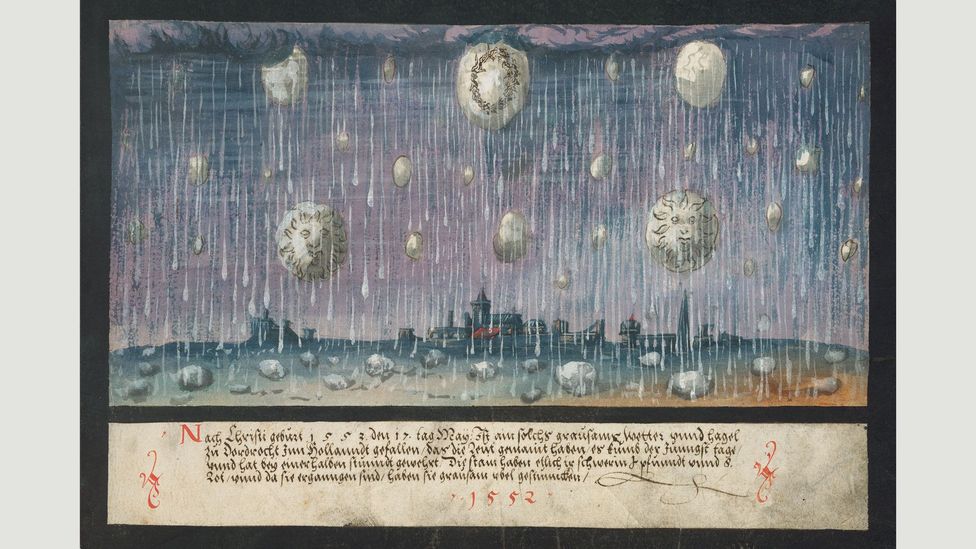
(Credit: The Book of Miracles / Taschen)
"In Advertizement 1552, on May 17, such a terrible tempest with hail descended on Dordrecht in Kingdom of the netherlands, that the people thought the 24-hour interval of Judgement was coming. And information technology lasted nigh half an hour. Several of the stones weighed upward to a few pounds and 8 lot. And where they brutal, they gave a frightful stench."
The hailstorm that visited the town of Dordrecht in 1552 is the most recent of the events noted in the Augsburg Book of Miracles. The illustrations of violent hail and snowstorms are considered some of the earliest depictions of weather in German art.
"Information technology was non uncommon for extreme meteorological phenomena such as hail, snow and ice to devastate crops and lead to famine and epidemics in their own right," writes Waterman. It is therefore understandable that these wild and devastating natural disasters would be linked with the apocalyptic consciousness of the era.
Fantastic beasts

(Credit: The Book of Miracles / Taschen)
The final section of the book, inspired by the prophecies of the Book of Revelation, is to Waterman, "a clear example of how wondrous phenomena fit inside a comprehensive ordering scheme of globe history, understood equally a progression from God's act of creation to the second coming of Jesus Christ."
The Augsburg Book of Miracles is a fascinating glimpse into an temper of superstition and apocalyptic prophecy. But rather than dismiss these views as bizarre medieval preoccupations, Waterman argues that "it'southward easy empathise with the 16th Century's efforts to understand strange, inexplicable, or disastrous events in the earth, fifty-fifty if our modernistic agreement is drastically dissimilar."
Age of anxiety
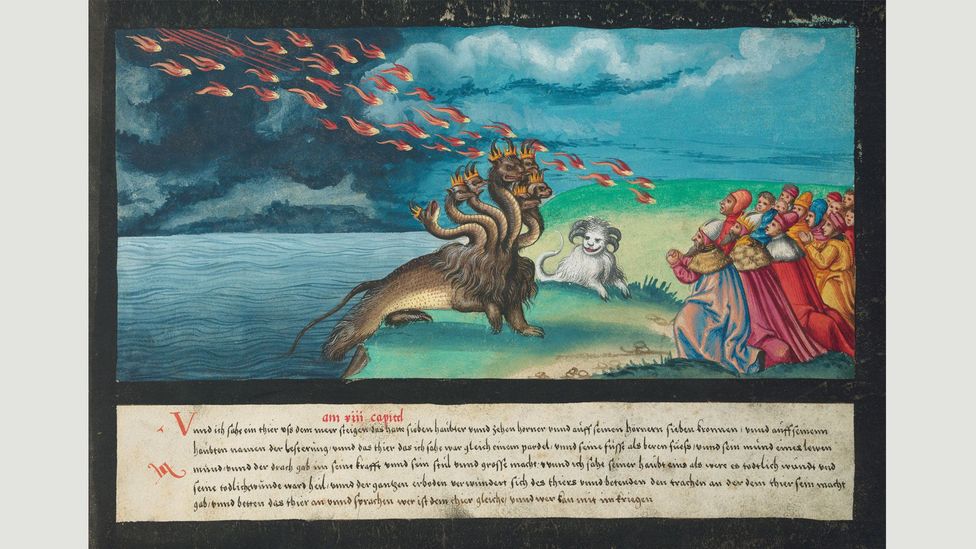
(Credit: The Volume of Miracles / Taschen)
And, in that society's "sphere of anxiety", Borchert sees some parallels with today, in that "every extreme weather miracle is hailed in news every bit proof of climatic change and these days, every set on everywhere is about instantly linked to terrorism."
Yet this concern with weather and natural phenomena provides a more concerning link between the mid-1500s and today, Waterman says. "Thinking about ecology catastrophes back and so and now, one becomes aware of a fell irony: whereas human sin was one time blamed for floods, storms, and droughts, just to have been replaced past scientific explanations after the Enlightenment, we have now, with global warming, come up full circle."
If you would like to annotate on this story or anything else you have seen on BBC Culture, head over to our Facebook page or message us on Twitter .
And if yous liked this story, sign up for the weekly bbc.com features newsletter , called "If You Only Read 6 Things This Week". A handpicked selection of stories from BBC Future, Globe, Culture, Capital and Travel, delivered to your inbox every Fri.
Source: https://www.bbc.com/culture/article/20170421-the-eerie-historical-visions-that-predict-the-apocalypse
0 Response to "Apocalypse Visions From the Book of Revelation in Western Art"
Enregistrer un commentaire